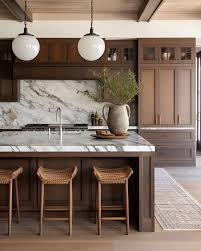
What’s on Trend for 2025: Kitchen, Bathroom, and Basement Design with a Biophilic Twist
Share
Discover Nature-Inspired Spaces: Transform Your Home with Biophilic Design
Written By: Camille Johnson
January 9, 2025

As we step into 2025, design trends are taking a turn toward wellness, sustainability, and a deeper connection to nature. One standout theme is biophilic design – an approach that integrates natural elements into interior spaces to enhance well-being and create harmonious environments. In this blog, we’ll explore the history and definition of biophilic design, why it’s trending for 2025 and beyond, and how incorporating it into kitchens, bathrooms, and basements can transform your home. We’ll also highlight why working with a skilled design-build general contractor is essential for achieving this aesthetic while ensuring functionality and quality.
The History and Definition of Biophilic Design
Biophilic design stems from the term “biophilia,” which means “love of life or living things.” Popularized by biologist Edward O. Wilson in the 1980s, biophilia describes humans’ innate connection to nature. This philosophy has deep historical roots, as ancient civilizations often designed homes and public spaces to harmonize with natural surroundings. Think of Japanese Zen gardens or Roman atriums – both early examples of blending indoor and outdoor elements.
In modern design, biophilic principles include:
- Natural light and ventilation
- Incorporating plants and greenery
- Using organic materials like wood, stone, and clay
- Nature-inspired patterns and textures
The goal is to create spaces that enhance physical and mental health, productivity, and happiness – a perfect alignment with today’s wellness-focused lifestyle.
Why Biophilic Design is on Trend for 2025
Biophilic design’s popularity is driven by a combination of wellness trends, environmental awareness, and aesthetic preferences:
- Increased Time Indoors: Post-pandemic, people value homes that support mental well-being.
- Sustainability Focus: Natural and eco-friendly designs align with green living initiatives.
- Search Data: “Biophilic design” has been a highly searched term, indicating growing interest among homeowners and designers.
For 2025, expect to see more homeowners seeking to bring nature inside, whether through expansive windows, living walls, or organic textures and colors.
Why You Need a Skilled Design-Build General Contractor
Biophilic design is as much about functionality as it is about aesthetics. Incorporating these elements into your kitchen, bathroom, or basement requires expertise in:
- Structural Planning: Maximizing natural light or adding windows/skylights.
- Material Selection: Choosing sustainable, durable products.
- Seamless Integration: Ensuring natural elements complement modern amenities.
A professional design-build contractor, like Lotus Home Improvement, can guide you through these intricacies, offering expert advice, 3D renderings, and tailored solutions.
Biophilic Design in Kitchens

The kitchen is the heart of the home, making it an ideal space for biophilic elements:
- Cabinets: Opt for wood finishes in warm tones or reclaimed materials for sustainability.
- Lighting: Incorporate pendant lights made from natural fibers or fixtures that mimic sunlight.
- Flooring: Choose stone tiles, bamboo, or hardwood.
- Greenery: Add herb gardens or potted plants to countertops or shelves.
- Windows: Expansive windows or sliding glass doors connect the kitchen to outdoor spaces.
Biophilic Design in Bathrooms

Bathrooms are evolving into wellness retreats, and biophilic design enhances this transformation:
- Materials: Use natural stone tiles, river rock shower floors, or wooden accents.
- Lighting: Install dimmable fixtures for a sunrise or sunset effect.
- Plants: Incorporate moisture-loving plants like ferns or orchids.
- Colors: Choose earthy tones like soft greens, blues, or sandy beiges.
- Features: Freestanding tubs placed near large windows or under skylights create a spa-like feel.
Biophilic Design in Basements
Basements are often underutilized but can become inviting spaces with biophilic touches:

- Lighting: Use layered lighting to mimic natural daylight in darker spaces.
- Flooring: Choose cork or engineered wood for warmth and comfort.
- Paint: Light, neutral colors can make the space feel airy and open.
- Greenery: Add planters with low-light plants like snake plants or philodendrons.
- Windows: If possible, incorporate larger egress windows to let in natural light.
Remodeling Products for Biophilic Design
When incorporating biophilic design into any space, thoughtful product choices make all the difference:
- Cabinetry: Opt for natural wood finishes or eco-friendly materials.
- Lighting: Look for fixtures that mimic natural sunlight or are crafted from organic materials.
- Flooring: Choose sustainable options like bamboo, cork, or reclaimed wood.
- Paint: Use non-toxic, VOC-free paints in earthy tones.
- Accessories: Incorporate woven baskets, live-edge wood furniture, or natural stone decor.
Final Thoughts
Biophilic design isn’t just a fleeting trend; it’s a lifestyle choice that promotes wellness, sustainability, and beauty. Whether you’re planning a kitchen remodel, bathroom upgrade, or basement transformation, integrating natural elements can elevate your space in both form and function. By partnering with a skilled design-build general contractor like Lotus Home Improvement, you can bring this stunning and impactful design approach to life.
Ready to embrace biophilic design? Contact us today for a complimentary consultation and start your journey toward a more natural, harmonious home.
